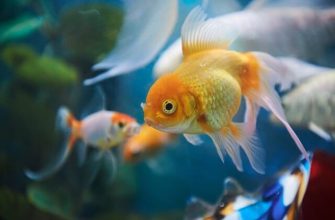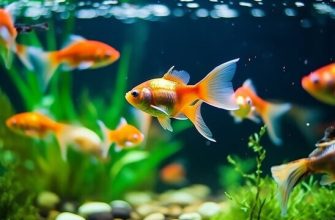It’s a common misconception that goldfish only come in orange. In fact, goldfish exhibit a wide variety of colors and patterns. Their scales contain pigment cells that give them rich hues of orange, red, black, brown, and sometimes even blue!
However, goldfish owners are often alarmed when their fish’s vibrant colors begin fading or changing altogether. A once-golden fish turning pale white or gray is a troubling sign. What causes these color transformations? Should you be worried? Read on to learn the reasons goldfish change color and what to do about it.
Normal Goldfish Color and Markings

Goldfish typically have orange, red, white, black, or combinations of these colors. The specific coloration depends on the breed. Common goldfish and comet goldfish are often solid orange or red-orange. Fancy goldfish like orandas and ryukins exhibit more color variation with mixes of orange, red, white, black, and sometimes metallic scales.
Young goldfish start out with more subdued brown/gray coloration. As they mature over their first year, the brighter orange and red pigments develop. Markings also become more defined as goldfish grow. Common patterns include solid, calico spotted, mottled, and variegated. The size, shape, and location of markings are unique to each fish. Normal color changes happen gradually over time. Dramatic overnight changes can signal an underlying issue.
Reasons for Color Change

Goldfish can change color for a variety of reasons related to their environment and health.
Some of the most common causes of color change include:
-
Temperature Changes – Goldfish are coldwater fish that prefer water temperatures between 65-72°F. If the water becomes too warm or fluctuates in temperature, it can cause stress leading to pale coloration.
-
Diet – Pigments in goldfish skin and scales come from carotenoids found in their diet. An improper diet low in spirulina, shrimp, or color-enhancing flakes can result in faded colors.
-
Lighting Changes – Goldfish need full spectrum lighting to maintain bright, vibrant colors. Too little light exposure can cause them to turn white or gray over time.
-
Water Quality Issues – Poor water quality stresses goldfish and affects their slime coat, which produces color pigments. Ammonia burns, nitrate poisoning, dirty water, or improper pH will lead to color loss.
-
Age – As goldfish grow older, their colors often fade or change. This is a natural part of aging.
Monitoring water quality, nutrition, lighting, and temperature helps minimize color change in goldfish due to environmental factors.
Loss of Color Pigment
Loss of color pigment, or melanin, is one of the most common reasons for a goldfish to turn white. Melanin is responsible for the dark colors in fish skin and scales. When melanin production decreases or stops, the dark colors fade and the fish loses its vibrant orange, black, or red colors.
Without melanin, the underlying silvery-white skin and scales start to show through. This gives the goldfish a washed out, pale appearance as the bright orange fades to white. Lack of melanin is often caused by old age, illness, stress, or poor water quality. Ensuring excellent water quality and reducing stressors can help maintain melanin production. But loss of color due to old age is irreversible.
Old Age

As goldfish age, their coloration often changes and they tend to lose some of the bright orange and yellow hues, turning more white or silver over time. This is a natural part of the aging process and not necessarily indicative of any illness.
Young goldfish tend to be very vibrant, with deep orange, black, and red colors. But as they reach maturity around 1-2 years old, their pigmentation starts to fade. Over time, the orange and red fades to pale yellow or white. This is especially common in fancy goldfish breeds like Orandas and Ryunkins that have been selectively bred to have fewer pigment cells.
The white color change is not harmful in and of itself. An aging goldfish that is active and eating normally is likely still healthy, just showing its seniority. Unless other symptoms arise, enjoy the distinguished look of your senior goldfish. The color change is a badge of honor earned through a long life in your care.
Illnesses
Certain diseases can cause loss of color in goldfish. Bacterial infections, while not the most common cause, are the most serious. If the goldfish has discolored white patches that look like salt grains, it likely has ich, also called white spot disease. Ich is a parasitic disease that attaches to the fish’s body and causes irritation, leading to color loss.
Other parasites like flukes can also result in fading color, twitching, excess mucus, and clamped fins. Overall, any illness that causes stress or skin irritation can potentially lead to temporary or permanent color loss in goldfish. Quick diagnosis and treatment is key.
Stress
Stress is a common cause of goldfish losing their color and turning white. This stress can come from poor water conditions, overcrowding, or even just moving the fish to a new tank.
If the water quality declines due to high ammonia or nitrite levels, the stress can cause the fish to lose color. Overcrowding leads to deteriorating water conditions, so having too many fish in a small tank is a frequent reason for stress-related color change. Even just moving the fish to a new aquarium can be stressful enough for them to lose color temporarily.
The key is to minimize stress by maintaining pristine water quality, avoiding overstocking, and acclimating fish slowly when moving them between tanks. Test water parameters frequently, do partial water changes, and don’t overload the tank. Reducing stress can help prevent and sometimes reverse the color loss.
Fixing Color Loss

Improving your goldfish’s diet can help restore its color. Feed a high-quality pellet food with carotenoids and spirulina to boost pigment production. You can also offer freeze-dried shrimp or bloodworms a few times per week. Reduce feeding low-nutrition flakes and limit treats.
Reducing stress is key for color loss from illness or anxiety. Perform regular water changes and test water parameters to keep the tank clean. Avoid overcrowding and give your goldfish plenty of room. Add hiding spots and plants for security. Check equipment like filters for issues causing disturbance.
If an illness is causing the color change, treat the root problem. Fungal infections, parasites, bacterial diseases, and more can drain color. Use medications targeted to the specific illness present after quarantining. Consult an aquarium specialist if unsure of the diagnosis. With proper care, your goldfish should regain its vibrant colors.
When to Worry
Signs that white color change may indicate serious issues include rapid color change, lethargy, lack of appetite, visible spots or lesions on the body, and scratching against objects in the tank. These symptoms often point to an underlying illness such as ich, a highly contagious parasitic disease. Ich causes small white dots resembling salt grains to appear on the fish’s body, fins and gills. As the disease progresses, increased mucus production and scratching may occur as the fish tries to rid itself of the parasite.
Rapid color change along with lethargy and lack of appetite is especially worrying, as it may indicate a severe bacterial infection or deteriorating water quality. Ammonia and nitrite poisoning from poor tank maintenance can stress fish to the point of color loss. High nitrate levels can also inhibit color pigment production over time. Any sudden changes in fish health or environment require quick action to test and improve water conditions.
Prolonged color loss in older fish is not necessarily alarming on its own. However, paired with abnormal behaviors like loss of buoyancy, labored breathing, or disinterest in food, it can signal health problems requiring medication or isolation from tankmates. White spots, lesions, frayed fins and cloudy eyes call for treatment as soon as possible. Catching and addressing diseases early improves recovery chances.
Conclusion
In summary, there are several common reasons why goldfish may lose their color and turn white. The most frequent causes are old age, illness, stress, or loss of pigment due to poor water quality or nutritional deficiencies. While a color change may just be a natural part of aging, it’s important to rule out disease by having a veterinarian examine the fish. Ensure proper goldfish care by maintaining excellent water quality through frequent partial water changes, using a good filtration system, and testing water parameters regularly.
Feed a high quality diet with variety and proper nutrition. Reduce stress by providing an adequately sized tank with hiding spots and avoiding overcrowding. With good husbandry practices, most goldfish should retain their vibrant colors well into old age. If you notice your goldfish losing color, act quickly to remedy any issues and restore its environment. Proper care will lead to a long, healthy life for your goldfish.








